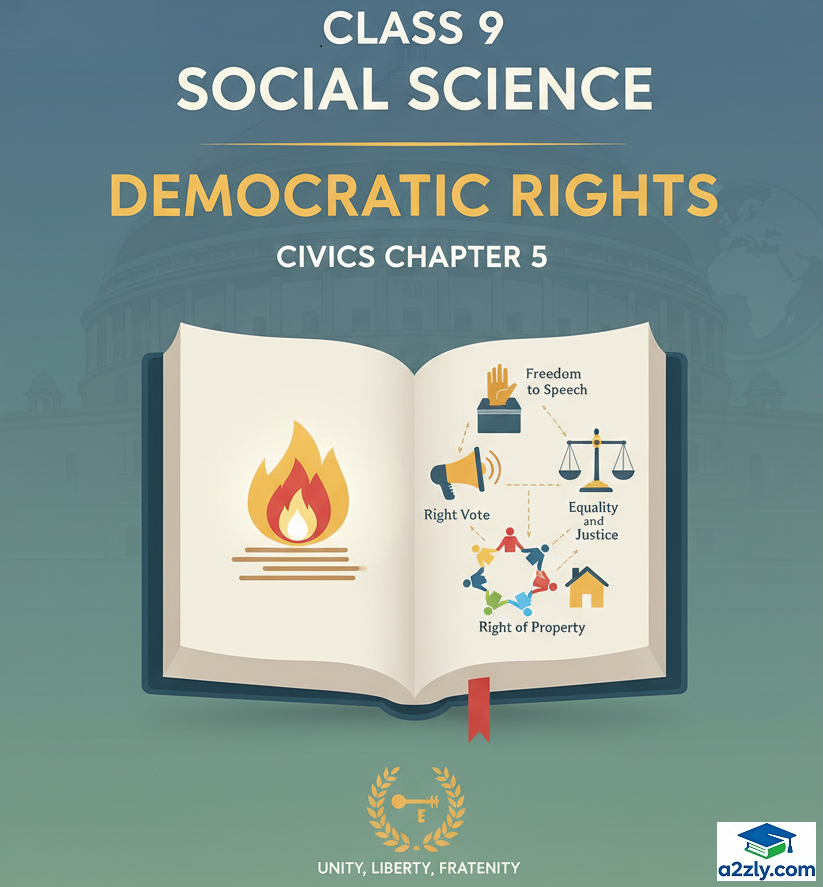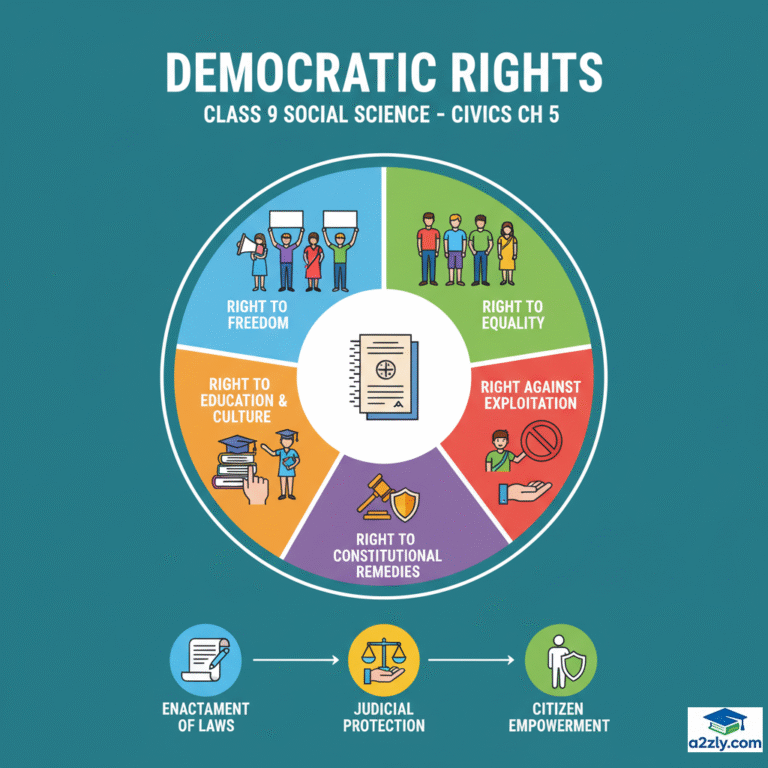Rights are the foundation of any democracy—they empower citizens to participate freely in society and protect them from injustice. In Class 9 Social Science Civics Chapter 5 – Democratic Rights, students learn about the fundamental rights guaranteed by the Indian Constitution and why they are essential for every citizen. This chapter explains how democratic rights ensure equality, freedom, and justice, helping learners understand the significance of protecting these rights in a healthy and functioning democracy.
TABLE OF CONTENTS

1. Short Notes for Revision from Ch 5: Democratic Rights
- Rights Definition: Claims of a person recognized by society and law. Essential for dignity and freedom.
- Need for Rights: Limit rulers’ power, ensure citizens’ dignity, freedom, equality. Make democracy meaningful.
- Life Without Rights: Examples like prisoners or suppressed groups (e.g., Saudi women pre-2018) show loss of freedom, justice.
- Fundamental Rights in India: Six rights in Constitution: Right to Equality, Freedom, Against Exploitation, Freedom of Religion, Cultural/Educational Rights, Constitutional Remedies.
- Right to Equality: No discrimination; equal opportunity. Includes abolition of untouchability (Article 17).
- Right to Freedom: Speech, assembly, movement, residence, profession, life (Article 19, 21). Subject to reasonable restrictions.
- Against Exploitation: Bans human trafficking, forced labor, child labor under 14 (Articles 23-24).
- Freedom of Religion: Free to practice, propagate religion (Article 25). Secular state ensures neutrality.
- Cultural/Educational Rights: Protect minorities’ language, culture; education access (Articles 29-30).
- Right to Constitutional Remedies: Approach courts for rights enforcement (Article 32). Called ‘heart’ by Ambedkar.
- Protection/Enforcement: Judiciary (Supreme Court, High Courts) enforces via writs like habeas corpus. Public Interest Litigation (PIL) aids citizens.
- Expanding Rights: New rights like education (2002, Article 21A), environment, privacy (2017) added through court rulings, amendments.
2. Multiple Choice Questions (MCQs)
- Rights are: A) Personal wishes B) Recognized claims C) Government orders D) Temporary rules
- Rights in democracy: A) Limit citizens B) Limit rulers C) No role D) Only for elite
- Fundamental Rights number: A) Five B) Six C) Seven D) Eight
- Right to Equality includes: A) Discrimination B) Abolition of untouchability C) Forced labor D) Religious restriction
- Right to Freedom covers: A) Speech only B) Speech, assembly, movement C) Property only D) No restrictions
- Against Exploitation bans: A) Free speech B) Child labor C) Voting D) Education
- Freedom of Religion: A) State religion B) Practice, propagate freely C) Bans religion D) No choice
- Constitutional Remedies: A) Article 19 B) Article 32 C) Article 25 D) Article 17
- Who enforces rights? A) Executive B) Judiciary C) Legislature D) Police
- Right to Education year: A) 2002 B) 1990 C) 2017 D) 1950
Answer Key: 1-B, 2-B, 3-B, 4-B, 5-B, 6-B, 7-B, 8-B, 9-B, 10-A
3. Very Short Answer Type Questions (VSAQs)
- What are rights? Answer: Recognized claims for dignity, freedom.
- Why needed? Answer: Limit rulers, ensure democracy.
- Fundamental Rights count? Answer: Six.
- Equality right? Answer: No discrimination, untouchability abolished.
- Freedom right? Answer: Speech, assembly, movement.
- Exploitation banned? Answer: Child labor, trafficking.
- Religion right? Answer: Free practice, propagation.
- Remedies article? Answer: Article 32.
- Who enforces? Answer: Judiciary.
- New right example? Answer: Education (2002).
4. Short Answer Type Questions (SAQs)
- Define rights. Answer: Rights are claims recognized by society and law. They ensure dignity and freedom.
- Why needed in democracy? Answer: Rights limit rulers’ power, protect citizens’ freedom. Make democracy meaningful.
- What is Right to Equality? Answer: Ensures no discrimination, equal opportunity. Abolishes untouchability (Article 17).
- Explain Right to Freedom. Answer: Includes speech, assembly, movement, profession (Article 19). Has reasonable restrictions.
- Right Against Exploitation? Answer: Bans trafficking, forced labor, child labor under 14 (Articles 23-24).
- Freedom of Religion? Answer: Free to practice, propagate religion (Article 25). State remains secular.
- Cultural/Educational Rights? Answer: Protect minority language, culture, education access (Articles 29-30).
- Constitutional Remedies? Answer: Allows approaching courts for rights enforcement (Article 32). Called heart of Constitution.
- Who protects rights? Answer: Judiciary enforces via writs like habeas corpus. PIL aids citizens.
- Expanding rights? Answer: New rights like education (2002), privacy (2017). Added by courts, amendments.
5. Long Answer Type Questions (LAQs)
- What are rights and why are they needed in a democracy? Answer: Rights are legally recognized claims ensuring dignity, freedom, and equality, like India’s Fundamental Rights. They are needed to limit rulers’ power, prevent oppression, and make democracy meaningful. Without rights, as seen in cases like Saudi women pre-2018, citizens lose freedom. In India, rights like equality and freedom ensure fair governance, upheld by the judiciary.
- Discuss the Fundamental Rights in India. Answer: The Indian Constitution lists six Fundamental Rights: Equality (no discrimination), Freedom (speech, movement), Against Exploitation (bans child labor), Religion (free practice), Cultural/Educational (minority rights), and Constitutional Remedies (court access). These, under Articles 14-32, protect citizens and ensure justice. For instance, Article 17 abolishes untouchability, reflecting India’s commitment to equality.
- How are rights enforced in India? Answer: The judiciary, led by the Supreme Court, enforces rights through writs like habeas corpus under Article 32, called the ‘heart’ by Ambedkar. Citizens can approach courts for violations, and Public Interest Litigation (PIL) helps marginalized groups. This system ensures accountability, as seen in landmark rulings expanding rights like privacy in 2017.
- Explain the expansion of rights. Answer: The scope of rights in India has grown through amendments and court rulings, adapting to new needs. For example, the Right to Education (Article 21A, 2002) ensured free education for ages 6-14. Privacy was recognized as a right in 2017. These expansions show how the Constitution evolves to protect citizens in a changing society.
- Describe life without rights with examples. Answer: Without rights, citizens face oppression, like prisoners denied freedom or Saudi women pre-2018 unable to drive or travel freely. In non-democratic setups, no legal recourse exists for injustice. India’s Fundamental Rights prevent such scenarios by ensuring equality and justice, with courts acting as guardians.
6. Source-Based / Case-Based Assessment Questions
Source Extract: (Overview) “Citizens’ democratic rights set limits on even the most properly elected rulers.”
Questions:
- What sets limits on rulers?
- Why needed?
- Example right?
- Enforcement?
- Impact?
Answer Key:
- Democratic rights.
- Prevent oppression.
- Equality.
- Judiciary.
- Fair governance.
Source Extract: (Fundamental Rights) “Indian Constitution provides six Fundamental Rights, including Right to Equality and Constitutional Remedies.”
Questions:
- Number of rights?
- Example right?
- Equality feature?
- Remedies role?
- Ambedkar’s view?
Answer Key:
- Six.
- Equality.
- No discrimination.
- Court enforcement.
- Heart of Constitution.
Source Extract: (Expanding Rights) “New rights like education (2002) and privacy (2017) have been added.”
Questions:
- New right example?
- Education right year?
- Privacy right year?
- How added?
- Why expand?
Answer Key:
- Education.
- Amendments, rulings.
- Meet new needs.
7. Solved Exercise-End Questions (NCERT Solutions)
- What are rights? Answer: Rights are legally recognized claims ensuring dignity, freedom, equality. They protect citizens in a democracy.
- Why are rights needed in a democracy? Answer: Rights limit rulers’ power, ensure freedom and equality. They make democracy meaningful.
- List the Fundamental Rights in India. Answer: Equality, Freedom, Against Exploitation, Religion, Cultural/Educational, Constitutional Remedies.
- What is Right to Equality? Answer: Ensures no discrimination, equal opportunity. Abolishes untouchability under Article 17.
- Explain Right to Freedom. Answer: Covers speech, assembly, movement, profession, life (Articles 19, 21). Has reasonable restrictions.
- What is Right Against Exploitation? Answer: Bans human trafficking, forced labor, child labor under 14 (Articles 23-24).
- Describe Freedom of Religion. Answer: Allows free practice, propagation of religion (Article 25). State remains secular.
- Who enforces rights? Answer: Judiciary, via Supreme Court and High Courts, using writs and PIL.
- What is Right to Constitutional Remedies? Answer: Allows citizens to approach courts for rights enforcement (Article 32). Called heart by Ambedkar.
- How have rights expanded? Answer: Through amendments (Education, 2002) and court rulings (Privacy, 2017). Adapts to new needs.
CONCLUSION
In conclusion, Democratic Rights Class 9 highlights that rights and responsibilities go hand in hand in a democracy. This chapter teaches students that democratic rights are not privileges—they are fundamental protections that allow citizens to live with dignity, express themselves freely, and participate actively in governance. By understanding and exercising these rights responsibly, students learn how democracy thrives and how justice and equality are maintained in society.

